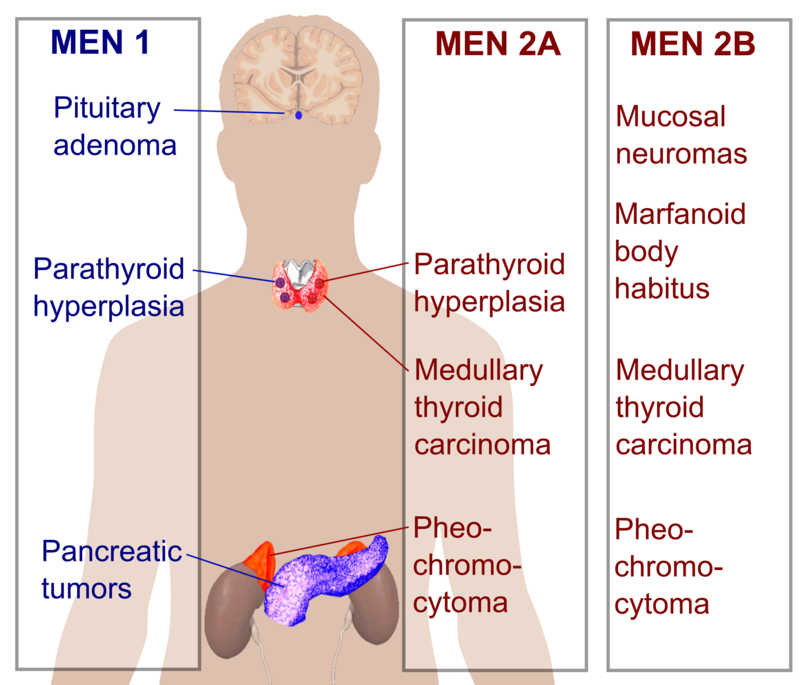Multiple endocrine neoplasia
 From Wikidoc - Reading time: 3 min
From Wikidoc - Reading time: 3 min
|
Multiple endocrine neoplasia Microchapters |
For patient information, click here.
Editor-In-Chief: C. Michael Gibson, M.S., M.D. [3]; Associate Editor(s)-in-Chief: Ammu Susheela, M.D. [4] Soroush Seifirad, M.D.[5]
Synonyms and keywords: MEN syndromes; Familial endocrine adenomatosis; Multiple endocrine adenomatosis; Multiple endocrine neoplasia syndrome; MEN; MEN-Multiple endocrine neoplasia syndrome; Multiple endocrine neoplasms
- For multiple endocrine neoplasia type 1, click here.
- For multiple endocrine neoplasia type 2a, click here.
- For multiple endocrine neoplasia type 2b, click here.
- For multiple endocrine neoplasia type 4, click here.
Overview[edit | edit source]
Multiple endocrine neoplasia (MEN) encompasses several distinct syndromes featuring tumors of endocrine glands, each with its own characteristic pattern. Multiple endocrine neoplasia may be classified according to tumor characteristics into 3 subtypes: multiple endocrine neoplasia type 1, multiple endocrine neoplasia type 2 and multiple endocrine neoplasia type 4.
Classification[edit | edit source]
- The following flowchart depicts the classification of multiple endocrine neoplasia.[1]
| Multiple endocrine neoplasia | |||||||||||||||||||||||||||||||||||||||||||||||||||||||||||||||||||||||||||||||||||||||
| Multiple endocrine neoplasia type 1 | Multiple endocrine neoplasia type 2 | Multiple endocrine neoplasia type 4 | |||||||||||||||||||||||||||||||||||||||||||||||||||||||||||||||||||||||||||||||||||||
| Multiple endocrine neoplasia type 2A | Multiple endocrine neoplasia type 2B/Multiple endocrine neoplasia type 3 | ||||||||||||||||||||||||||||||||||||||||||||||||||||||||||||||||||||||||||||||||||||||
| Multiple endocrine neoplasia type 2A classical | Multiple endocrine neoplasia type 2A with cutaneous lichen amyloidosis | Multiple endocrine neoplasia type 2A with Hirschsprung disease | Familial medullary thyroid carcinoma without pheochromocytoma or parathyroid hyperplasia | Medullary thyroid cancer, pheochromocytoma, marfanoid habitus, and mucosal neuromas or intestinal ganglioneuromas | |||||||||||||||||||||||||||||||||||||||||||||||||||||||||||||||||||||||||||||||||||
Comparison[edit | edit source]
- The following diagram compares the various types of multiple endocrine neoplasia.[2]

- The following table compares the various types of multiple endocrine neoplasia.[3]
| Feature | MEN 1 | MEN 2 | ||
|---|---|---|---|---|
| MEN 2A | MEN 2B | FMTC | ||
| Eponym | Wermer syndrome | Sipple syndrome | (multiple) | (none) |
| OMIM | Template:OMIM4 | Template:OMIM4 | Template:OMIM4 | Template:OMIM4 |
| Pancreatic tumors | gastrinoma (50%[4]), insulinoma (20%[4]), vipoma, glucagonoma, PPoma |
- | - | - |
| Pituitary adenoma | 66%[4] | - | - | - |
| Angiofibroma | 64%*[5] | - | - | - |
| Lipoma | 17%*[5] | - | - | - |
| Parathyroid hyperplasia | 90%[4] | 50%[4] | - | - |
| Medullary thyroid carcinoma | - | 100%[4] | 85%[4] | 100% |
| Pheochromocytoma | - | >33%[4] | 50% | - |
| Marfanoid body habitus | - | - | 80% | - |
| Mucosal neuroma | - | - | 100%[4] | - |
| Gene(s) | MEN1 (Template:OMIM4) | RET (Template:OMIM4) | RET (Template:OMIM4) | RET (Template:OMIM4), NTRK1 (Template:OMIM4) |
| Approx. prevalence | 1 in 35,000 (1 in 20,000 to 1 in 40,000)[6] |
1 in 40,000[7] | 1 in 1,000,000 (1 in 600,000[8] to 1 in 4,000,000[9])[10] |
|
| Initial description (year) | 1954[11] | 1961[12] | 1965 | |
*- of patients with MEN1 and gastrinoma
{{#ev:youtube|9e5YudJLRYc}}
References[edit | edit source]
- ↑ Wells SA, Asa SL, Dralle H, Elisei R, Evans DB, Gagel RF; et al. (2015). "Revised American Thyroid Association guidelines for the management of medullary thyroid carcinoma". Thyroid. 25 (6): 567–610. doi:10.1089/thy.2014.0335. PMC 4490627. PMID 25810047.
- ↑ Multiple endocrine neoplasia type 2. Wikipedia(30.09,2015)https://en.wikipedia.org/wiki/Multiple_endocrine_neoplasia accessed on September, 30, 2015
- ↑ Multiple endocrine neoplasia type 2. Wikipedia(30.09,2015)https://en.wikipedia.org/wiki/Multiple_endocrine_neoplasia accessed on September, 30, 2015
- ↑ 4.0 4.1 4.2 4.3 4.4 4.5 4.6 4.7 4.8 Table 4-7 in:Elizabeth D Agabegi; Agabegi, Steven S. (2008). Step-Up to Medicine (Step-Up Series). Hagerstwon, MD: Lippincott Williams & Wilkins. ISBN 0-7817-7153-6.
- ↑ 5.0 5.1 Asgharian, B; Turner, ML; Gibril, F; Entsuah, LK; Serrano, J; Jensen, RT (November 2004). "Cutaneous tumors in patients with multiple endocrine neoplasm type 1 (MEN1) and gastrinomas: prospective study of frequency and development of criteria with high sensitivity and specificity for MEN1". The Journal of Clinical Endocrinology and Metabolism. 89 (11): 5328–36. doi:10.1210/jc.2004-0218. PMID 15531478.
- ↑ [1] 123I labeled metaiodobenzylguanidine for diagnosis of neuroendocrine tumors. Jiang L, Schipper ML, Li P, Cheng Z, Reports in Medical Imaging. 2009: 2 79-89
- ↑ Dora JM, Siqueira DR, Meyer EL, Puñales MK, Maia AL (November 2008). "Pancreatitis as the first manifestation of multiple endocrine neoplasia type 2A". Arq Bras Endocrinol Metabol. 52 (8): 1332–6. doi:10.1590/S0004-27302008000800021. PMID 19169490.
- ↑ Marx, Stephen J (2011). "Chapter 41: Multiple endocrine neoplasia". In Melmed, Shlomo. Williams Textbook of Endocrinology, 12th ed. pp. 1728–1767.
- ↑ Moline J, Eng C. (2011). "Multiple endocrine neoplasia type 2: An overview". Genetics in Medicine. 13 (9): 755–764. doi:10.1097/GIM.0b013e318216cc6d. PMID 21552134.
- ↑ Martino Ruggieri (2005). Neurocutaneous Disorders : The Phakomatoses. Berlin: Springer. ISBN 3-211-21396-1. - Chapter: Multiple Endocrine Neoplasia Type 2B by Electron Kebebew, Jessica E. Gosnell and Emily Reiff. Pages 695-701. [2] This reference quotes a prevalence of 1 in 40,000, but this figure is inconsistent with the same reference's calculated incidence of 4 per 100 million per year for MEN2B.
- ↑ Wermer P (1954). "Genetic aspects of adenomatosis of endocrine glands". Am. J. Med. 16 (3): 363–71. doi:10.1016/0002-9343(54)90353-8. PMID 13138607.
- ↑ Sipple JH (1961). "The association of pheochromocytoma with carcinoma of the thyroid gland". Am. J. Med. 31: 163–6. doi:10.1016/0002-9343(61)90234-0.
 KSF
KSF